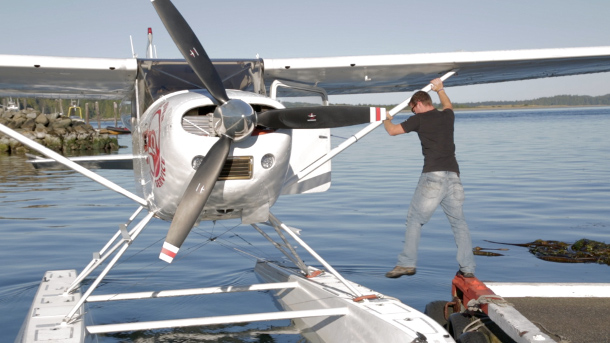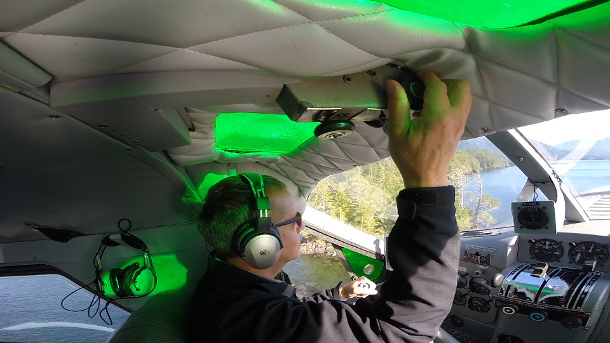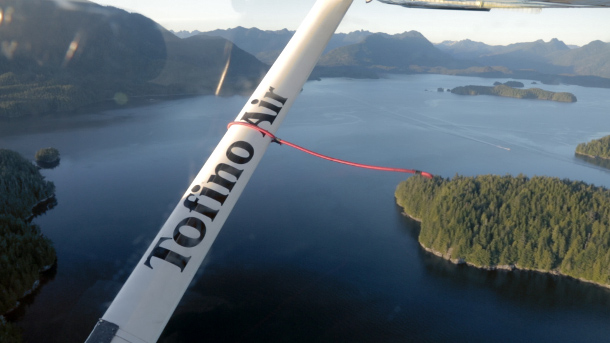It is common amongst the residents of the Salish Sea region to give short-term hospitality to friends and relatives hailing from far-flung corners of the globe. As pleasant as these occasions often are, they always seem to be preceded by awfully belaboured and incredibly awkward explanations of how their final destination should best be reached. "Yes, Vancouver Island is actually an island and you will need to cross the sea." "No, really, there is no bridge option." "Horseshoe Bay, not Tsawwassen." "Tsawwassen, not Horseshoe Bay." "Not on Wednesday mornings; it's dangerous cargo day!" "Once on the island ask for the McAllisters' home; they moved away 20 years ago, but that's what everybody calls our house." And so on.
Exasperated by the possibility of yet more occurrences of would-be visitors' confused geography, some two years ago I resolved to no longer direct my distant friends' wayward souls through a maze of ships, taxi rides, and improbable hitch-hikes and instead began to suggest that they fly on a floatplane straight to my island. "Once you get to YVR, go to the river and ask for Sean or Klaus. If it's not too foggy or too dark you'll be on Gabriola in no time."
As bizarre as this cheeky set of directions may have sound, the reply I received from its initial recipient turned out to be even more surprising: "Sean or Klaus? You actually know the pilots' names?"
"Huh!" I thought, "I suppose I do." I suppose we all do, out here.
It is not so much the fact that floatplane pilots are bound by Transport Canada regulations to state their first name to passengers every time they perform their carefully-memorized safety spiel -- just in case, you know, you needed to get their attention as the plane falls out of the sky -- but rather the much more interesting fact that on a floatplane it is the pilots themselves with whom you deal. It is they who walk you to your aircraft, who load your luggage, who distribute earplugs in lieu of peanuts, and who sit right next to you as they take your life in their capable hands. So, "how could I possibly not know their names?" -- I answered my distant friend, feeling somewhat offended by his urbanite tendency to take anonymity as the universal norm.
About a year ago, however, I felt that knowing my pilots' names would suffice no longer. Weary of the news media's tendency to care about floatplanes only under the most tragic of circumstances, I decided to reach out to nearly every commercial operator based in the region and asked for pilots to share with me what it's like to be in their seat. I wanted to know how they manage to fly machines that, for the most part, haven't been manufactured since The Doors released their debut album. I was curious about why they didn't sign up to fly fancier heavy iron instead. And most of all, I ached to learn why they fly so low and so slow.
Forgotten flight
Contemporary sociologists, geographers, transport planners, and historians constantly strive to outdo one another in pronouncing the dramatic compression of world time and space in virtue of the airplane's role in redefining global distances and political relations. Yet none of these pundits seem to remember that there are types of planes other than "the" airplane, and other ways to cross the sky. Ways that are much lower than 36,000 feet, much slower than 870 km/h, and still no less socially and culturally significant.
Granted, floatplanes are pretty easy to forget. Their terminals seldom amount to little more than airports' backyards or floating docks -- perhaps shared with bait-and-tackle shops or small-town whale-watching outfitters. The planes themselves are even less glamorous. There are no Dreamliners or Concords; only 'Beavers," "Otters," and "Gooses" -- or perhaps forgettable "180s" or the brand new "Caravan," which in spite of its sleek lines still sounds like a mini-van.

And the float pilots? You won't see them peacocking around lush departure gates with coattails of attendants and hangers-on marching in step with them. You won't rub shoulders with them as they hop between Bali, Rio, and Paris. Rather, you'll run into floatplane pilots while they offload Costco cardboard boxes, muddy backpacks, and fishing rods, or maybe spot them -- by hearing them long before you see them -- as they descend their way to places like Bamfield, Quatsino Sound, and Port Alice.
It's a bright summer morning when I meet Jim -- recently retired from 34 years of flying with 10 different operators -- at "the spit" in Campbell River. Jim is still actively involved with the Floatplane Operators Association and is an inexhaustible source of information. Even though there are numerous commercial operators on the East Coast, in Ontario, and the North -- Jim tells me -- conditions on the West Coast are particularly fertile for the floatplane business.
Not only is the weather good enough for flying nearly year-round, but there are countless remote communities scattered throughout the coast which deeply depend on floatplanes for mail, supplies, and access to often distant health facilities, seasonal employment, and connections with the rest of the world. Float plane flying -- you might say -- is as iconic a B.C. job as fishing, logging, and dealing with real estate.
To boot, there are First Nation communities, scientists, ecologists, hikers, government workers from Fisheries and Oceans, surveyors, celebrities and filmmakers among ordinary everyday floatplane customers, says Louis, of one-man company Ucluelet-based West Coast Wild Adventures. "And of course, whale-watchers."
Freedom with a catch
Like Jim, Louis has been flying for years and over time he has developed a deep appreciation of his job. He has just dropped off two European tourists, and myself, after a weather-perfect flight over the Broken Group Islands, and he seems as giddy as if this were his first flight ever. "You are part of a community when you fly floatplanes," he tells me, "I can fly into a small village and everyone will know my name."
"I've turned Air Canada down before," he adds, "I contemplated that at the beginning of my career, but I'm a boy that enjoys the bush and I enjoy being home every night. I've been married for 36 years. I don't think there's a lot of commercial airline pilots that can say that."

And yet, the job is not exactly easy on families. "The tourism comes in peaks so you will find work more readily in the summertime," Jim remarks, "one day you'd get a call from an operator up North... and off I'd go. Pack my bags and go fly for him or her for the summer... The following year that operator may go out of business or have moved on or sold the business or have had to lay people off because of the lack of work. So it can be a very transient lifestyle for some."
Some pilots crave that freedom. You could be putting out fires one week (arguably the best gig for your pockets) and hopping between idyllic Caribbean islands the next week (arguably the best gig for your social life). But you could also be out of work for the next six months, or perhaps you might be living out of a van in Tofino until Labour Day.
"The industry can be very trying on your family life," Jim explains as a Cessna noisily approaches the Campbell River spit on a return trip from somewhere in Desolation Sound, "you're under the same roof as your family but you get up in the morning as your family is sleeping. You work all day, then you come home and they've already gone to bed. So you're living in the same house but you're not watching and experiencing and participating in your children's life growing up." And what's worse, you're doing all that mostly in the summer, when you'd rather be fishing or camping.
On the other hand, by piloting a floatplane on our coast you get to live in paradise. For people like Vancouver Island-born Sean, of Gulf Island Seaplanes, that lifestyle choice is what spurred him two years ago to take the leap from pilot to owner-pilot. As we sit downwind from the savory aromas wafting from Richmond's Flying Beaver Bar & Grill -- the B.C. seaplane crowd's answer to exclusive first class airport waiting lounges -- Sean outlines for me the recent history of the industry:
"It's all evolved. In the past, in the '70s, '80s, it was a lot of forestry and fishing. A lot of that was the work. Now it's tourism driven. You know, the west coast, Tofino, the island all up and down. And up the North Coast there's fishing. Not commercial fishing, it's sport fishing and eco-trips: they're going to see grizzly bears… And then we have here Vancouver, Nanaimo, Victoria with a lot of commuters going back and forth. [...] There's a lot of people who live on Gabriola and go to work [to the mainland] every week, every day. You know, it's the customer that I know. I can grab a bag and not even look up and I can say, 'Hey Bill, how you doing?' Cause I know the bag."

As ferry fares continue to rise, and as more exurban types continue to make small and larger islands their full-time or part-time home, the floatplane industry keeps on expanding. Harbour Air -- the region's largest float airline -- can now count no fewer than 55 aircrafts in its fleet and stable pilot salaries to top that.
'Like flying in a postcard'
Though no official statistics exist, most floatplane pilots will tell you that they make about one-third less, if not half less, of what an Air Canada pilot with similar experience might make. For some floatplane pilots that can mean $30,000 a year, and for others with more seniority and successful corporate employers that can mean upwards of $90,000. The passion they fly with, however, is priceless.
To make sense of that passion, we need to understand a couple of basic facts about floatplane design. Floatplanes, unlike jets, do not have pressurized cabins. This makes it impossible for them to fly high above the weather and to fly fast. Nonetheless, floatplanes do not wish -- if desire is something they could find the words to express over their loud engines -- to fly fast. Short take-off and landing capacities, known as STOL, are far more important to them and their pilots. STOL makes it possible to land and depart from small lakes, protected bays, and narrow fjords. Agility rather than speed, and versatility rather than height, mean that floatplane flight must be practiced low and slow in order to be safe. Going low and slow also means that seaplane flight will be experienced as an engaging immersion into the world, rather than a detached suspension above it.
"It's like flying in a postcard," Art tells me. Born in Ontario, where he learned to fly with his dad while he was "still in diapers," Art is now the Chief pilot for Harbour Air. "It's never the same," he explains. Floatplane pilots have the relative freedom -- "we have to be disciplined to," he qualifies -- to land anywhere they want, to choose their routes, to make their own decisions, and to exercise their professional knowledge of weather, technology, and place.
"More than a science," Art concludes, "it's a form of art." ![]()
Read more: Travel, Transportation














Tyee Commenting Guidelines
Comments that violate guidelines risk being deleted, and violations may result in a temporary or permanent user ban. Maintain the spirit of good conversation to stay in the discussion.
*Please note The Tyee is not a forum for spreading misinformation about COVID-19, denying its existence or minimizing its risk to public health.
Do:
Do not: